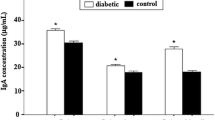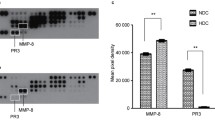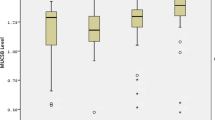Abstract
The aim of this study was to analyze the organic composition of saliva from children without dental caries and children with early childhood caries (ECC). Two groups of 20 children varying in age from 12 to 47 months were selected: Group I, caries-free children; Group II, children with early childhood caries (ECC). Samples of saliva were collected from each subject and submitted to immunological and biochemical assays. Measurements of total salivary IgA, IgG and IgM were performed by using nephelometric techniques, while total protein concentrations and amylase activity were determined by colorimetric techniques. Comparisons of values between groups were made by using U Mann-Whitney test (p<0.05). Children with ECC presented significantly higher levels of total salivary IgA and IgG, while the mean values of amylase activity, total protein concentrations and total IgM were similar between the groups. In this study, the presence of ECC was associated with an increase in total salivary IgA.
Similar content being viewed by others
References
Akiyoshi N, Rocha RSS, Rosa OPS et al (1998) Quantification of secretory IgA and its correlation with salivary levels of mutans streptococci and lactobacilli in 7- and 8-year-old children. Rev Odontol Univ São Paulo 12:129–136
Alaluusua S (1983) Longitudinal study of salivary IgA in children from 1 to 4 years old, with reference to dental caries. Scand J Dent Res 91:163–168
Ben-Aryeh H, Lapid S, Szargel R et al (1984) Composition of whole-unstimulated saliva of human infants. Archs Oral Biol 29:357–362
Bolton R, Hlava G (1982) Evaluation of salivary IgA antibodies to cariogenic microorganisms in children. Correlation with dental caries activity. J Dent Res 61:1225–1228
Botey J, Martí E, Eseverri JL et al (1981) Niveles de immunoglobulinas a distintas edades en la población sana. Allergol et Immunopathol 9:19–24
Brandtzaeg P (1983) The oral secretory immune system with special emphasis on its relation to dental caries. Proc Finn Dent Soc 79:71–84
Brandtzaeg P (1989) Salivary immunoglobulins. In: Tenovuo J (ed) Human saliva—clinical chemistry and microbiology. CRC Press, Boca Raton, Florida, pp 01–54
Challacombe SJ (1980) Serum and salivary antibodies to Streptococcus mutans in relation to the development and treatment of human dental caries. Arch Oral Biol 25:495–502
Fujiwara T, Sasada E, Mima N et al (1991) Caries prevalence and salivary mutans streptococci in 0–2-year-old children of Japan. Community Dent Oral Epidemiol 19:151–154
Grähn E, Tenovuo J, Lehtonen O-P et al (1988) Antimicrobial systems of human whole saliva in relation to dental caries, cariogenic bacteria and gingival inflammation in young adults. Acta Odontol Scand 46:67–74
Grindefjörd M, Dahlöf G, Ekström G et al (1993) Caries prevalence in 2.5-year-old children. Caries Res 27:505–510
Grindefjörd M, Dahllöf G, Wikner S et al (1991) Prevalence of mutans streptococci in one-year-old children. Oral Microbiol Immunol 6:280-83
Hyyppä T, Karhuvaara L, Tenovuo J et al (1989) Antimicrobial factors in whole saliva of humans infants: a longitudinal study. Pediat Dent 11:30–36
Kargul B, Yarat Ajanbo Gl et al (1994) Salivary protein and some inorganic element levels in health children and their relationship to caries. J Marmara Univ Dent Fac 2:434–440
Kaufman RA, Tietz NW (1980) Recent advances in measurements of amylase activity—a comparative study. Clin Chem 26:846–853
Lagerlöf F, Oliveby A (1994) Caries-protective factors in saliva. Adv Dent Res 8:229–238
Lehtonen O-PJ, Grähn EM, Stählberg TH et al (1984) Amount and avidity of salivary and serum antibodies against Streptococcus mutans in two groups of human subjects with different dental caries susceptibility. Infect Immunity 43:308–313
Orsonneau J-L, Douet P, Massoubre C et al (1989) An improved pyrogallol red-molybdate method for determining total urinary protein. Clin Chem 35:2233–2236
Petti S, Cairella G, Tarsitani G (2000) Rampant early childhood dental decay: an example from Italy. J Public Health Dent 60:159–166
Quartey J, Williamson D (1999) Prevalence of early childhood caries at Harris County Clinics. J Dent Child 66:127–131
Ramos-Gomez F, Tomar S, Ellison J et al (1999) Assessment of early childhood caries and dietary habits in a population of migrant Hispanic children in Stockton, California. J Dent Child 66:395–403
Reisine S, Douglas J (1998) Psychosocial and behavioral issues in early childhood caries. Community Oral Epidemiol 26:32–44
Rose P, Gregory K, Linda E et al (1994) IgA antibodies to Streptococcus mutans in caries resistant and susceptible children. Pediat Dent 16:272–275
Seow W (1998) Biological mechanisms of early childhood caries. Community Dent Oral Epidemiol 26:8-27
Shore K, Kirkham J, Brookes S, Wood S et al (2000) Distribution of exogenous proteins in caries lesions in relation to the pattern of demineralization. Caries Res 34:188–193
Tenovuo J, Lehtonen O-PJ, Aaltonen AS (1987) Serum and salivary antibodies against Streptococcus mutans in young children with and without detectable oral S. Mutans. Caries Res 21:289–296
Tenovuo J, Lehtonen O-PJ, Aaltonen AS et al (1986) Antimicrobial factors in whole saliva of infants. Infect Immun 51:49–53
Tinanoff N, O'Sullivan D (1997) Early childhood caries: overview and recent findings. Pediat Dent 19:12–16
Twetman S, Lindner A, Modéer T (1981) Lysozyme and salivary immunoglobulin A in caries-free and caries susceptible pre-school children. Swed Dent J 5:9–14
Weintraub JA (1998) Prevention of early childhood caries: a public health perspective. Community Dent Oral Epidemiol 26:62–66
Xú T, Oppenheim F (1992) Salivary antimicrobials: where are we? In: Bowen WH, Tabak LA (eds) Cariology for the Nineties. University of Rochester Press, Rochester, NY, pp 117–131
Yasaki SC, Koga-Ito CY, Jorge AO et al (1999) Anti-Streptococcus mutans IgA in children with and without dental caries. Rev Odontol Univ São Paulo 13:211–217
Acknowledgments
We would like to thank Dr. Humberto de Paula and Dr. Antonio Gonzales for providing laboratory facilities at Pasteur Laboratory (Brasilia-DF, Brazil), and for their special assistance. We are also grateful to Dr. Claucus Mercatelli (Dade Behring Company, São Paulo, Brazil) for providing the necessary material for the laboratorial assays.
Author information
Authors and Affiliations
Corresponding author
Rights and permissions
About this article
Cite this article
Gonçalves de Farias, D., Barreto Bezerra, A.C. Salivary antibodies, amylase and protein from children with early childhood caries. Clin Oral Invest 7, 154–157 (2003). https://doi.org/10.1007/s00784-003-0222-7
Received:
Accepted:
Published:
Issue Date:
DOI: https://doi.org/10.1007/s00784-003-0222-7




